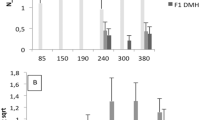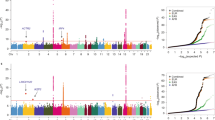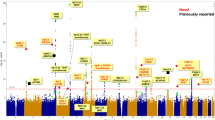Abstract
The pulmonary adenoma susceptibility 1 (Pas1) locus affects inherited predisposition and resistance to chemically induced lung tumorigenesis in mice. The A/J and C57BL/6J mouse strains carry the susceptibility and resistance allele, respectively. We identified and genotyped 65 polymorphisms in the Pas1 locus region in 29 mouse inbred strains, and delimited the Pas1 locus to a minimal region of 468 kb containing six genes. That region defined a core Pas1 haplotype with 42 tightly linked markers, including intragenic polymorphisms in five genes (Bcat1, Lrmp, Las1, Ghiso, and Kras2) and amino-acid changes in three genes (Lrmp, Las1, Lmna-rs1). In (A/J × C57BL/6J)F1 mouse lung tumors, the Lmna-rs1 gene was completely downregulated, whereas allele-specific downregulation of the C57BL/6J-derived allele was observed at the Las1 gene, suggesting the potential role of these genes in tumor suppression. These results indicate a complex multigenic nature of the Pas1 locus, and point to a functional role for both intronic and exonic polymorphisms of the six genes of the Pas1 haplotype in lung tumor susceptibility.
This is a preview of subscription content, access via your institution
Access options
Subscribe to this journal
Receive 50 print issues and online access
$259.00 per year
only $5.18 per issue
Buy this article
- Purchase on Springer Link
- Instant access to full article PDF
Prices may be subject to local taxes which are calculated during checkout





Similar content being viewed by others
References
Akamatsu Y . (1975). J. Natl. Cancer Inst., 55, 893–897.
Askling J, Grunewald J, Eklund A, Hillerdal G and Ekbom A . (1999). Am. J. Respir. Crit. Care Med., 160, 1668–1672.
Bauer AK, Dwyer-Nield LD, Keil K, Koski K and Malkinson AM . (2001). Exp. Lung Res., 27, 197–216.
Behrens TW, Jagadeesh J, Scherle P, Kearns G, Yewdell J and Staudt LM . (1994). J. Immunol., 153, 682–690.
Brownson RC and Alavanja MC . (2000). Cancer Causes Control, 11, 853–858.
Burkhard P, Stetefeld J and Strelkov SV . (2001). Trends Cell Biol., 11, 82–88.
Cormier R, Hong K, Halberg R, Hawkins T, Richardson P, Mulherkar R, Dove W and Lander ES . (1997). Nat. Genet., 17, 88–91.
Cormier RT, Bilger A, Lillich AJ, Halberg RB, Hong KH, Gould KA, Borenstein N, Lander ES and Dove WF . (2000). Oncogene, 19, 3182–3192.
Darvasi A and Pisante-Shalom A . (2002). Trends Genet., 18, 489–491.
De Luca M, Roshina NV, Geiger-Thornsberry GL, Lyman RF, Pasyukova EG and Mackay TF . (2003). Nat. Genet., 34, 429–433.
Devereux TR, Wiseman RW, Kaplan N, Garren S, Foley JF, White CM, Anna C, Watson MA, Patel A, Jarchow S, Maronpot RR and Anderson MW . (1994). Mamm. Genome, 5, 749–755.
Dragani TA . (2003). Cancer Res., 63, 3011–3018.
Eden A and Benvenisty N . (1999). FEBS Lett., 457, 255–261.
Festing MFW, Yang A and Malkinson AM . (1994). Genet. Res., 64, 99–106.
Gariboldi M, Manenti G, Canzian F, Falvella FS, Radice MT, Pierotti MA, Della Porta G, Binelli G and Dragani TA . (1993). Nat. Genet., 3, 132–136.
Hanahan D and Weinberg RA . (2000). Cell, 100, 57–70.
Johnson L, Mercer K, Greenbaum D, Bronson RT, Crowley D, Tuveson DA and Jacks T . (2001). Nature, 410, 1111–1116.
Kawakami K, Salonga D, Park JM, Danenberg KD, Uetake H, Brabender J, Omura K, Watanabe G and Danenberg PV . (2001). Clin. Cancer Res., 7, 4096–4101.
Liang T, Spence J, Liu L, Strother WN, Chang HW, Ellison JA, Lumeng L, Li TK, Foroud T and Carr LG . (2003). Proc. Natl. Acad. Sci. USA, 100, 4690–4695.
Malkinson AM . (1989). Toxicology, 54, 241–271.
Malkinson AM and Beer DS . (1984). J. Natl. Cancer Inst., 73, 925–933.
Manenti G, Acevedo A, Galbiati F, Giannì Barrera R, Noci S and Dragani TA . (2002). Int. J. Cancer, 99, 555–559.
Manenti G, Stafford A, De Gregorio L, Gariboldi M, Falvella FS, Avner P and Dragani TA . (1999). Genome Res., 9, 639–646.
Maria DA, Manenti G, Galbiati F, Ribeiro OG, Cabrera WK, Giannì Barrera R, Pettinicchio A, De Franco M, Starobinas N, Siqueira M, Dragani TA and Ibanez OM . (2003). Oncogene, 22, 426–432.
Mayne ST, Buenconsejo J and Janerich DT . (1999). Am. J. Epidemiol., 149, 13–20.
Re FC, Manenti G, Borrello MG, Colombo MP, Fisher JH, Pierotti MA, Della Porta G and Dragani TA . (1992). Mol. Carcinogen., 5, 155–160.
Shaughnessy Jr JD, Largaespada DA, Tian E, Fletcher CF, Cho BC, Vyas P, Jenkins NA and Copeland NG . (1999). Oncogene, 18, 2069–2084.
Steinmetz LM, Sinha H, Richards DR, Spiegelman JI, Oefner PJ, McCusker JH and Davis RW . (2002). Nature, 416, 326–330.
Trainin N, Linker-Israeli M, Small M and Boiato-Chen L . (1967). Int. J. Cancer, 2, 326–336.
Wade CM, Kulbokas III EJ, Kirby AW, Zody MC, Mullikin JC, Lander ES, Lindblad-Toh K and Daly MJ . (2002). Nature, 420, 574–578.
Wang M, Lemon WJ, Liu G, Wang Y, Iraqi FA, Malkinson AM and You M . (2003). Cancer Res., 63, 3317–3324.
Webb KE, Martin JF, Cotton J, Erusalimsky JD and Humphries SE . (2003). Exp. Hematol., 31, 488–494.
Wiltshire T, Pletcher MT, Batalov S, Barnes SW, Tarantino LM, Cooke MP, Wu H, Smylie K, Santrosyan A, Copeland NG, Jenkins NA, Kalush F, Mural RJ, Glynne RJ, Kay SA, Adams MD and Fletcher CF . (2003). Proc. Natl. Acad. Sci. USA, 100, 3380–3385.
Zhang Z, Futamura M, Vikis HG, Wang M, Li J, Wang Y, Guan KL and You M . (2003). Proc. Natl. Acad. Sci. USA, 100, 12642–12647.
Zhang Z, Wang Y, Vikis HG, Johnson L, Liu G, Li J, Anderson MW, Sills RC, Hong HL, Devereux TR, Jacks T, Guan KL and You M . (2001). Nat. Genet., 29, 25–33.
Acknowledgements
This work was funded in part by grants from Associazione and Fondazione Italiana Ricerca Cancro (AIRC and FIRC).
Author information
Authors and Affiliations
Corresponding author
Rights and permissions
About this article
Cite this article
Manenti, G., Galbiati, F., Giannì-Barrera, R. et al. Haplotype sharing suggests that a genomic segment containing six genes accounts for the pulmonary adenoma susceptibility 1 (Pas1) locus activity in mice. Oncogene 23, 4495–4504 (2004). https://doi.org/10.1038/sj.onc.1207584
Received:
Accepted:
Published:
Issue Date:
DOI: https://doi.org/10.1038/sj.onc.1207584
Keywords
This article is cited by
-
Decreased tumorigenesis in mice with a Kras point mutation at C118
Nature Communications (2014)
-
The error-prone DNA polymerase ι provides quantitative resistance to lung tumorigenesis and mutagenesis in mice
Oncogene (2014)
-
Cis-acting genomic elements of the Pas1 locus control Kras mutability in lung tumors
Oncogene (2008)
-
The Kras2 oncogene and mouse lung carcinogenesis
Medical Molecular Morphology (2008)
-
The Idd6.2 diabetes susceptibility region controls defective expression of the Lrmp gene in nonobese diabetic (NOD) mice
Immunogenetics (2007)



